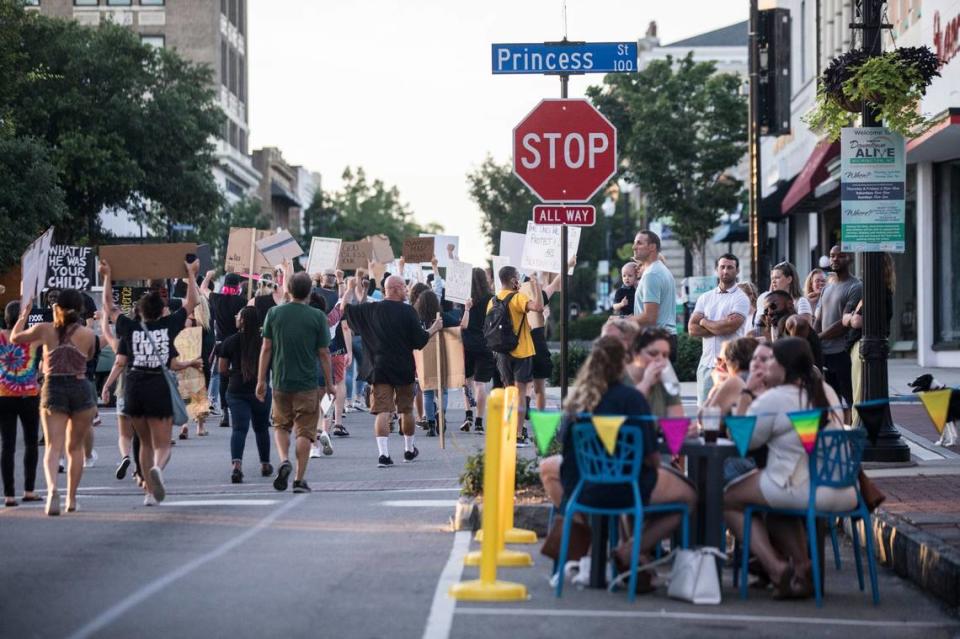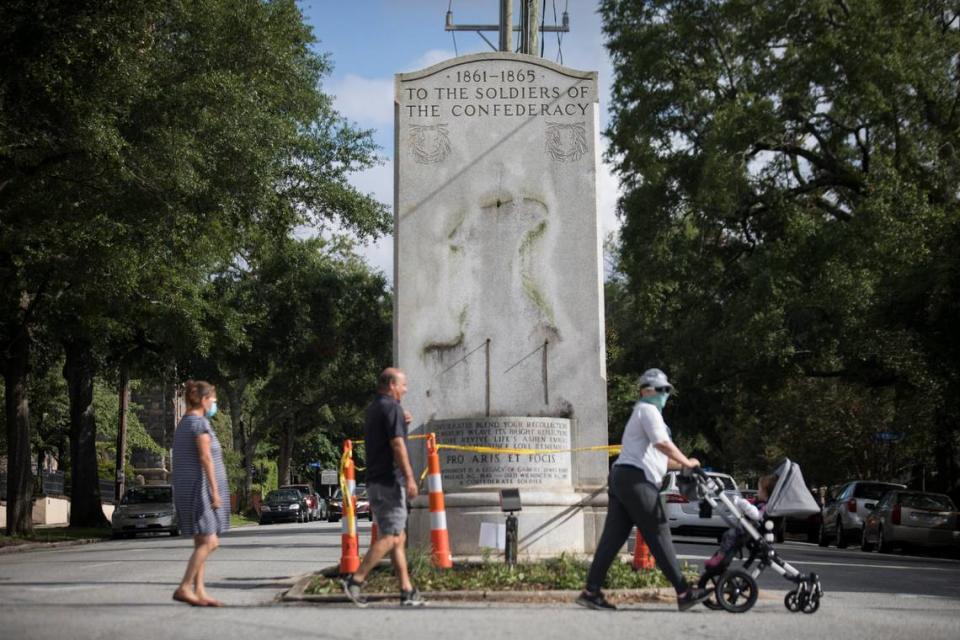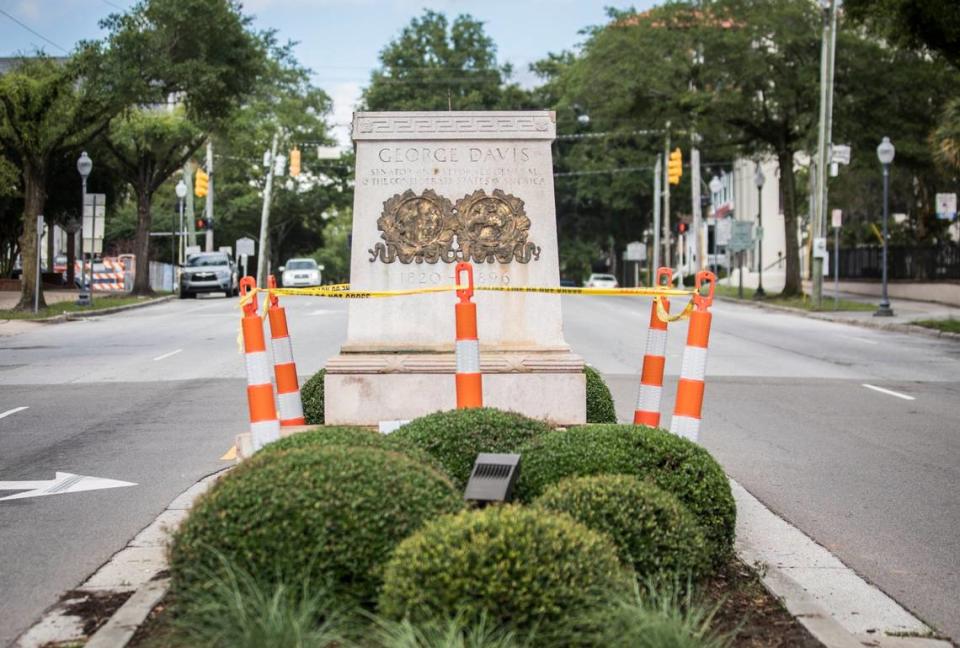As racist police make headlines, Wilmington confronts its past and hears calls for change
Lily Nicole threw up when she heard the racist remarks of three now-fired Wilmington Police Department officers.
When a friend who does not live in Wilmington called Nicole’s partner to ask about their safety and remark that they are on the front lines of the nation’s protest, Nicole realized the gravity of an event that would soon be featured on national news broadcasts.
“In my mind I knew that they were there, I mean I’m not stupid, that’s what we’re fighting. I’ve had interactions with some stupid racist comments, so I’ve experienced it. But for a friend who’s not here, a story that went beyond our port, to call because he was concerned about our safety because we’re literally toe to toe with these people and have been for like 25, 26 nights, that was really scary,” Nicole said.
Nicole emerged as an organizer of Wilmington’s movement on the protests’ second night, May 31, when she tried to work with then-interim WPD Chief Donny Williams to protect the crowds in the middle of downtown’s Front Street. Since then, Nicole and a group of protesters have met on the steps of Wilmington City Hall every day. The group, now called the lowercase leaders, has a permit to do so until next June.
Since George Floyd’s death in Minneapolis, protesters have been consistently taking to the streets of large cities like Raleigh and Charlotte, calling for limited public resources to be reallocated from policing communities to supporting them. Those same conversations have reached smaller cities, too, like Wilmington, an often-sleepy port town that would normally be in the midst of a bustling tourism season as temperatures warmed up.
This week, Wilmington was in national headlines after a two-day period that started Tuesday when Donny Williams, a Black police officer who grew up in the city’s public housing, was officially named police chief. On Wednesday, in one of his first official actions, Williams fired three police officers after a vehicle’s camera captured them making racist remarks toward Black officers, protesters and residents of the city. And in the overnight hours Thursday, the city lowered two Confederate statues, citing the same public safety exemption Gov. Roy Cooper used to clear statues from State Capitol grounds in Raleigh.
It was a week that captured the pain of a city that was the site of the 1898 race massacre, a place where schools have slumped toward resegregation in recent years. But also one that captured the possibility of a moment where protesters are calling for long-awaited change.

Racist police officers
A Wilmington Police Department sergeant found the conversations during a routine review of footage, seemingly recorded when a camera in Kevin Piner’s patrol car was accidentally activated earlier this month. In the first conversation, Piner discusses the events of recent days with Brian Gillmore. Piner said he heard that the Wilmington Police Department was being criticized for failing to be active enough with protesters. The men also discussed two Black colleagues, with Gillmore saying he saw a picture of one officer “down there sitting on his (expletive)” and Piner saying another was “bad news” before adding “let’s see how his boys take care of him when (expletive) gets rough, see if they don’t put a bullet in his head.”
Piner had the second conversation with Jesse Moore, who was a corporal at the time. During that conversation, Moore is heard referring multiple times to a woman he arrested as a “negro” and a “(racial slur).” Moore also used racial slurs against a Wilmington magistrate who asked whether the woman could have been involuntarily committed instead of criminally charged.
“She needed a bullet in her head right then and move on. Let’s move the body out of the way and keep going,” Moore said, according to WPD’s report.
“That’s what I’ve been trying to tell you,” Piner responded.
Later in the call, Piner said he was ready for a civil war, according to the WPD report, that he was planning to purchase a new assault rifle and that society is nearing martial law.
Piner said, “We are just gonna go out and start slaughtering them (expletive) (racial slur). I can’t wait. God I can’t wait.”
When Moore said he would not do that, Piner replied, “I’m ready.”
All three now-fired officers had been on the Wilmington Police force for longer than 20 years.
When Samuel Murrell heard the officers’ words Thursday, he said it was “like exhuming the ghost of 1898.”
Murrell is a religions professor at UNC Wilmington who has also studied the city’s massacre.
Shortly after moving to Wilmington in 1995, Murrell said, he was driving two of his sons to school when another driver aggressively chased him through traffic on a busy road screaming some of the same racial slurs the police officers used.
“This is the only place I was called the n-word,” said Murrell, who added that officers have frequently stopped his two sons when they are entering the family’s largely white suburban neighborhood.
On Thursday night, J.T. Smith brought a sign with Piner’s words about slaughtering Black people to the steps of Wilmington City Hall, where protesters have been gathering every day for nearly a month. Smith carried the sign up Third Street, down Dock Street and then back up Front Street, past a largely white crowd that was dining on the typically busy street.
It was important, Smith said, for everyone to see Piner’s uncensored words.
“If you want to say these things, say them and you have to be accountable. Everyone will know,” Smith said. “And if you don’t want people to know, don’t say it.”
Piner’s words, Smith said, made it clear that the former officer considers Black people to be sub-human. Smith and several other protesters said they were not surprised to hear that police officers held those views.
“When I’m scared in my car driving, that’s what is going on in (police officer’s),” Smith said. “When I am just trying to get to where I am going, they’re out here having these conversations. It makes me wonder, who can I trust?”

‘We asked for it years ago’
Drivers entering downtown Wilmington from Martin Luther King Junior Parkway pass six vertical paddles jutting into the air on their left, the city’s memorial to the massacre of 1898. The memorial was dedicated in 2008, 110 years after the only successful coup d’etat in United States history, one that saw white men violently overthrow Black elected officials.
Until the early hours of Thursday morning, when those drivers reached Market Street they would see a monument to George Davis, a New Hanover County native who became the fourth attorney general of the Confederacy, on their left. Also visible was the Confederate Memorial, which stood at Third and Dock.
Tim Joyner and his father first made that drive in 2004, when Joyner came to attend orientation UNC Wilmington.
“My dad told me that those statues were telling Black people to go back where they came from, and I’ll never forget that. Every time I drive by it, that’s what I think of,” Joyner said.
Joyner was one of two men charged with spray painting “BLM” and a swastika on the monument at Third and Dock earlier this month.
The Confederate statues came down this week, less than 12 hours after Williams fired the three racist officers.
“About damn time. We asked for it years ago,” said Nicole, recalling a recent conversation with a neighbor about previous efforts for the statues to be relocated.
Joyner said he was one of the first people to notice the statues had been removed from their pedestals and called local news stations to let them know what was happening.
On Thursday night, Joyner led the march past the still-intact bases of the statues. At Dock and Third, smudges of black and green on the stone outlined where the likeness of a Confederate soldier had gazed over one of Wilmington’s busiest thoroughfares since the monument was dedicated in 1924.
After passing the bases, marchers headed up Front Street, passing through a street fair-type initiative that recently started to allow restaurants struggling with the impacts of COVID-19 serve food outside at tables in the heart of the city’s historic downtown. As the protesters passed the mostly white diners, some raised fists from their table. At least one diner glanced over his shoulder before extending his middle finger.
Unlike so many other marches where protesters cycle through chants, there was only one on Thursday: “(Expletive) them statues.”

‘A full reckoning’
When the group of about 80 protesters finished marching, they circled around Joyner on the Third Street sidewalk next to City Hall.
He told them they should observe a moment of silence for the activists who had lost hope when their own efforts to bring down the monuments were unsuccessful, for those who believed their efforts had been in vain. As passersby honked their horns, Joyner said his own hope had been restored by those gathered around him.
“Our lives don’t just matter when we die,” Joyner said. “Let’s celebrate while we can, but before we celebrate, let’s have a moment of silence for those whose spirits are broken and have yet to be repaired.”
William Sturkey, a UNC-Chapel Hill history professor, said monuments to the Confederacy across the South were meant to show nostalgia for a time when white supremacy was the law of the land. Regarding 1898 specifically, Sturkey pointed to Kenan Memorial Stadium at the UNC-Chapel Hill, originally named for William Rand Kenan Sr., a captain in the Wilmington massacre. (In 2018, UNC officials removed a plaque at the stadium honoring Kenan and renamed the stadium after his son, William Rand Kenan Jr.)
And in Wilmington itself, Hugh MacRae park sits near the intersection of College Road and Oleander Drive, 98 acres bearing the name of one of the coup’s organizers.
“What the country really deserves and what the region really needs is nothing less than a full reckoning with our past,” Sturkey said. “We need to acknowledge fully what happened.”
That means, Sturkey said, recognizing which people and institutions played roles in the racist parts of American history and saying clearly that those actions are wrong.
“We need to make that moral judgment so we can move forward,” Sturkey said. “So it’s not OK for police officers to sit there and say, ‘Let’s wipe out all the Blacks.’ “
Across North Carolina, many have grown up without learning about the events of 1898, something that is often even true in Wilmington-area public schools. Several protesters who grew up in Wilmington said they did not learn that part of the city’s history in school. Others like Smith, who grew up in Fayetteville, and Coleman Paiva, who grew up in Wake County, did not know about the coup until well after moving to Wilmington.
“It is kind of funny that at this moment, when a lot of people say you can’t erase history, it turns out you sure as hell can,” Sturkey said.
Nicole and the lowercase leaders are trying to fix that. In recent days, Nicole has met with local teachers and is exploring creating a local history curriculum that could be used during elective periods or reading time.
“I will go door-to-door to every school and sit down and tell them why they should include this,” Nicole said, “and that would be a huge step because it’s getting the kids knowledgeable about where they live.”

What comes next
On the steps of city hall Thursday night, protesters said they don’t think officials are listening to them. Yes, the monuments were taken down. But, Joyner said, it only happened after the racist police were exposed.
And yes, Williams had formally been hired as police chief, something that was on a list of seven demands activists put forth. But that was going to happen anyway, something that Wilmington Mayor Bill Saffo confirmed in a Friday interview with the News & Observer.
Of Williams’ hire, Nicole said, “It’s like one of those analogies, you know, you gave the dog the bone but they’re still starving for more? They gave us something just to pacify, but we’re very happy that he was fully instated. He definitely deserved it.”
Protesters’ other demands include a request that $5 million be re-allocated for community led restorative justice programs; that a civilian review board be formed with subpoena power and budget approval power and that police receive access to therapy, as well as local history training. They are also calling for the mandatory use of body cameras during every interaction with the public and the deprioritization of misdemeanor drug offenses.
“I think that it’s all a lot of smoke and mirrors from the local government,” said Mychaela Barner, 19. “I don’t think they care about our seven demands, but I think they’ll soon learn we’re not going away. This is an everyday thing.”
Saffo, who has been the city’s mayor since 2007, said Friday that he is listening to the protesters, who are often chanting just feet away from his office window. He said he is willing to meet with the group’s leaders at any time, but would prefer to do it inside city hall rather than on the steps.
Wilmington is, Saffo noted, going to consider a civilian review board and did hire Williams.
When asked whether he would call for state law to be changed so that a police review board could have subpoena power, Saffo said, “I think if somebody has subpoena powers, that should be done in an elected body, not an appointed body.”
Furthermore, Saffo said he is willing to consider re-allocating additional city funds to nonprofits, but that requests to make the changes came too late in this year’s cycle.
Regarding police, Saffo said he would like to see the new chief undertake a full review of the department’s policies, similar to one that was conducted by the Police Executive Research Forum in 2004.
“An organization as big as that one, a ($35.84 million) budget, needs to be evaluated every five years,” Saffo said, specifically citing the training of officers and their pre-hire psychological evaluations as places he would like to see review, spurred by the remarks earlier in the week.
When he heard the officers’ remarks, Saffo recalled, he was in a room with other members of city council, some city administrators and Williams. Saffo said the room was completely silent as the remarks played, everyone shocked.
“How did these guys hide it? And what would make them say stuff like that? Did they have specific biases from the get-go, were these biases built over time?” Saffo said.
Williams has, Saffo said, been given the approval to evaluate every officer in the department to find anyone else who may be harboring racist sentiments similar to those held by the fired officers.
“We need to make sure that the department has the support of the community,” Saffo said, “because if it doesn’t, we’re not going to be able to solve crimes and we’re not going to be able to do our job.”
Nicole and the other protesters plan to continue pushing Saffo and the city for change. They see progress in the fact that protests are still ongoing, that there are still dozens of people showing up almost four weeks after the first gathering.
“We raised a little ruckus, got some monuments taken, chief became chief, which is well deserved,” Nicole said.
Next, she has her sights set on something tangible: Incorporating the lowercase leaders as a nonprofit and launching a community breakfast program on Wilmington’s Southside.
“We want to help and invest and be one with them,” Nicole said.
This reporting is financially supported by Report for America/GroundTruth Project and The North Carolina Local News Lab Fund, a component fund of the North Carolina Community Foundation. The News & Observer maintains full editorial control of the work. To support the future of this reporting, subscribe or donate.

